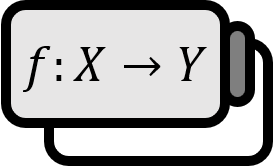Origin of Trigonometric Functions
Explanation
In mathematics, there are functions called trigonometric functions. These include $\sin, \cos, \tan, \sinh, \sec, \dots$ and others. They are collectively referred to as trigonometric functions because they are fundamentally related to triangles. Each of their names also originates from geometric meanings related to triangles.

$\sin$
Let’s assume a right triangle like the one shown in the figure above. If the angle between the base and the hypotenuse is $\theta$, the function defined as follows is called the sine function.
$$ \sin \theta := \dfrac{y}{\sqrt{x^{2}+y^{2}}} $$
The notation for the sine function $\sin$ is an abbreviation of “sine.” It originated from the Latin word sinus, which means “to bend, a bent place.” This name is given because the graph of the sine function resembles a curve drawn by the ratio of the hypotenuse to the height. 1
$\cos$
The function defined as follows is called the cosine function $\cos$.
$$ \cos \theta := \sin \theta^{\prime} = \dfrac{x}{\sqrt{x^{2}+y^{2}}} $$
Many names of trigonometric functions have the prefix co-, which is an abbreviation of complementary. It is said that the use of “cosinus” by Edmund Gunter in his book in 1620 was the first. Geometrically, it is the sine function for the other acute angle not defined by the sine function.
$\tan$
The function defined as follows is called the tangent function $\tan$.
$$ \tan \theta := \dfrac{y}{x} = \dfrac{\sin \theta}{\cos \theta} $$
As seen in the figure below, the tangent of a triangle with a base length of $1$ is related to the length of the tangent to the unit circle. Therefore, it is named $\tan$ from the word tangent.

$\sec$
The function defined as follows is called the secant function $\sec$.
$$ \sec \theta := \dfrac{1}{\cos \theta} = \dfrac{\sqrt{x^{2}+y^{2}}}{x} $$
As seen in the figure below, the secant of a triangle with a base length of $1$ is related to the length of the secant of the unit circle. Therefore, it is named $\sec$ from the word secant.

$\csc$, $\cot$

$\csc$ is an abbreviation for cosecant, meaning the secant of the other angle in a right triangle as in the case of $\cos$. It has the same value as the reciprocal of the sine function.
$$ \csc \theta := \dfrac{1}{\cos \theta^{\prime}} = \dfrac{1}{\sin \theta} = \dfrac{\sqrt{x^{2}+y^{2}}}{y} $$
$\cot$ is an abbreviation for cotangent, similarly meaning the tangent of the other angle in a right triangle. It has the same value as the reciprocal of the tangent function.
$$ \cot \theta := \tan \theta^{\prime} = \dfrac{x}{y} = \dfrac{1}{\tan \theta} = \dfrac{\cos \theta}{\sin \theta} $$
